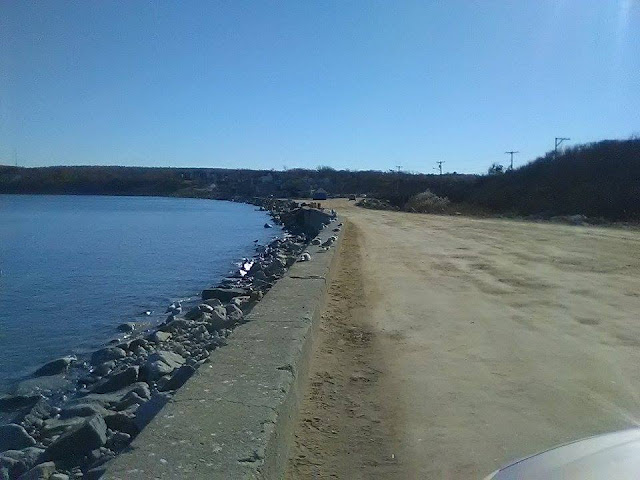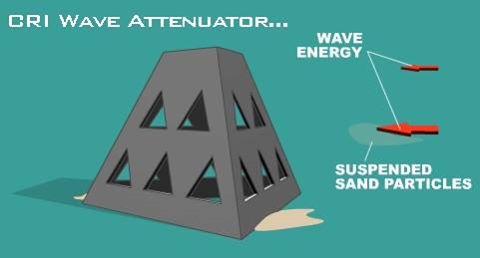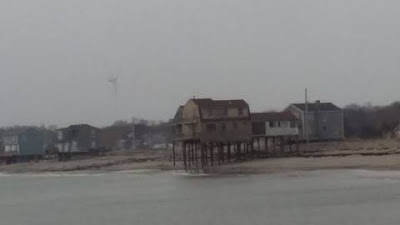The situation is going downhill quickly, as they say.
Tropical Storm Hermine emerged off of the Carolina coast as a strong tropical storm, and is forecast to regain hurricane status as it meanders around just south of us.
We could be in for several days of high surf and beach erosion. Like a nor'easter, this storm will aim 4-8 mean tides at Massachusetts beaches.
The National Weather Service has issued a
Tropical Storm Watch (meaning that Tropical Storm conditions are possible within 48 hours) for all of the South Coast, both islands, Cape Cod and extreme Southern Plymouth County.
Plymouth, Kingston, Duxbury and points north are not currently under any watches or warnings from the NWS, but that could change with their 5 PM update.
We urge our readers to take whatever precautions are necessary, especially if you are on the coast. Seas will build for several days, and will have some fierce winds behind them.
It's looking like a Sunday night arrival, with a terrible Monday, a rotten Tuesday, and an improving but still coastal-floodish Wednesday and perhaps Thursday.
Two important things to keep in mind:
1) Hurricane Irene barely touched us, and some places had no power for 2 weeks.
and
2) A slight, and I mean slight westward jiggle of the track gives us a direct hit of a powerful tropical storm on Nantucket, and a slightly northern jiggle gives in a Barnstable/Chatham landfall.
Happy Labor Day! We'll be back with many updates.
 |
| Add caption |
**TROPICAL STORM WATCH IS IN EFFECT FOR THE SOUTH COASTS OF RHODE
ISLAND AND MASSACHUSETTS INCLUDING THE ISLANDS**
NEW INFORMATION
---------------
* CHANGES TO WATCHES AND WARNINGS:
- A TROPICAL STORM WATCH HAS BEEN ISSUED FOR SOUTHERN BRISTOL
MA...SOUTHERN PLYMOUTH MA...BARNSTABLE MA...DUKES
MA...NANTUCKET MA...SOUTHEAST PROVIDENCE RI...EASTERN KENT
RI...BRISTOL RI...WASHINGTON RI...NEWPORT RI AND BLOCK ISLAND RI
* CURRENT WATCHES AND WARNINGS:
- A TROPICAL STORM WATCH IS IN EFFECT FOR SOUTHERN BRISTOL
MA...SOUTHERN PLYMOUTH MA...BARNSTABLE MA...DUKES
MA...NANTUCKET MA...SOUTHEAST PROVIDENCE RI...EASTERN KENT
RI...BRISTOL RI...WASHINGTON RI...NEWPORT RI AND BLOCK ISLAND RI
* STORM INFORMATION:
- ABOUT 450 MILES SOUTHWEST OF NANTUCKET MA
- 36.1N 75.2W
- STORM INTENSITY 65 MPH
- MOVEMENT EAST-NORTHEAST OR 60 DEGREES AT 15 MPH
SITUATION OVERVIEW
------------------
SITUATION OVERVIEW
TROPICAL STORM HERMINE WILL AFFECT THE RHODE ISLAND AND MASSACHUSETTS
SOUTH COAST WITH WIND...ROUGH SURF...DANGEROUS RIP CURRENTS AND BEACH
EROSION. A TROPICAL STORM WATCH IS NOW IN EFFECT FOR THE SOUTH COASTS
OF RHODE ISLAND AND MASSACHUSETTS INCLUDING BLOCK ISLAND...MARTHA/S
VINEYARD...NANTUCKET AND CAPE COD. TROPICAL STORM FORCE CONDITIONS ARE
MOST LIKELY FROM LATE SUNDAY THROUGH MONDAY MORNING. SINCE HERMINE IS
EXPECTED TO STALL SOUTH OF NEW ENGLAND...SQUALLS WITH TROPICAL STORM
FORCE GUSTS MAY AFFECT THE RHODE ISLAND AND MASSACHUSETTS SOUTH COAST
THROUGH MID WEEK.
TROPICAL STORM FORCE WINDS MAY ARRIVE ACROSS BLOCK ISLAND...MARTHA/S
VINEYARD AND NANTUCKET BY SUNDAY AFTERNOON AND SPREAD ALONG THE THE
SOUTH COAST FROM WESTERLY RHODE ISLAND TO CHATHAM MASSACHUSETTS
SOMETIME SUNDAY EVENING. WIND GUSTS BETWEEN 40 AND 50 MPH ALONG THE
IMMEDIATE SOUTH COAST AND ISLANDS MAY DOWN SOME TREES AND LARGE
BRANCHES WITH SCATTERED POWER OUTAGE. SOME TREES MAY BE MORE
SUSCEPTIBLE TO WIND DAMAGE DUE TO STRESS FROM DROUGHT CONDITIONS.
ALONG THE SHORE...DANGEROUSLY ROUGH SURF AND LIFE THREATENING RIP
CURRENTS ARE LIKELY SUNDAY INTO THE MIDDLE PART OF NEXT WEEK...
ESPECIALLY ALONG RHODE ISLAND AND MASSACHUSETTS SOUTH COAST BEACHES. A
STORM SURGE OF 2 TO 3 FEET MAY OCCUR DURING THE SUNDAY NIGHT AND
MONDAY HIGH TIDES ALONG THE RHODE ISLAND COAST FROM WESTERLY TO POINT
JUDITH. A 1 TO 2 FOOT STORM SURGE IS LIKELY ALONG THE REST OF THE
RHODE ISLAND AND MASSACHUSETTS SHORELINES. HIGH SURF ON TOP OF THE
ELEVATED WATER LEVELS MAY CAUSE MINOR TO MODERATE BEACH EROSION ALONG
THE RHODE ISLAND COAST BETWEEN WESTERLY AND POINT JUDITH INCLUDING THE
MISQUAMICUT BEACH AND CHARLESTOWN AREAS. MINOR BEACH EROSION IS
POSSIBLE ALONG THE REST OF THE OCEAN EXPOSED RHODE ISLAND AND
MASSACHUSETTS SHORELINES.
A FEW HEAVY DOWNPOURS ARE POSSIBLE SUNDAY NIGHT INTO EARLY NEXT WEEK
ACROSS RHODE ISLAND AND SOUTHEAST MASSACHUSETTS...BUT FLOODING OF
STREAMS AND RIVERS APPEARS UNLIKELY AT THIS TIME.
POTENTIAL IMPACTS
-----------------
* WIND: PREPARE FOR DANGEROUS WIND HAVING POSSIBLE SIGNIFICANT
IMPACTS ACROSS THE SOUTH COAST. POTENTIAL IMPACTS IN THIS AREA
INCLUDE:
- SOME DAMAGE TO ROOFING AND SIDING MATERIALS, ALONG
WITH DAMAGE TO PORCHES, AWNINGS, CARPORTS, AND SHEDS. A FEW
BUILDINGS EXPERIENCING WINDOW, DOOR, AND GARAGE DOOR FAILURES.
MOBILE HOMES DAMAGED, ESPECIALLY IF UNANCHORED. UNSECURED
LIGHTWEIGHT OBJECTS BECOME DANGEROUS PROJECTILES.
- SEVERAL LARGE TREES SNAPPED OR UPROOTED, BUT WITH GREATER
NUMBERS IN PLACES WHERE TREES ARE SHALLOW ROOTED. SEVERAL FENCES
AND ROADWAY SIGNS BLOWN OVER.
- SOME ROADS IMPASSABLE FROM LARGE DEBRIS, AND MORE WITHIN URBAN
OR HEAVILY WOODED PLACES. A FEW BRIDGES, CAUSEWAYS, AND ACCESS
ROUTES IMPASSABLE.
- SCATTERED POWER AND COMMUNICATIONS OUTAGES,
BUT MORE PREVALENT IN AREAS WITH ABOVE GROUND LINES.
* FLOODING RAIN:
LITTLE TO NO IMPACTS ARE ANTICIPATED AT THIS TIME ACROSS
SOUTHERN NEW ENGLAND.
* TORNADOES:
LITTLE TO NO IMPACTS ARE ANTICIPATED AT THIS TIME
ACROSS SOUTHERN NEW ENGLAND.
PRECAUTIONARY/PREPAREDNESS ACTIONS
----------------------------------
* EVACUATIONS:
IF YOU ARE EXCEPTIONALLY VULNERABLE TO WIND OR WATER HAZARDS FROM
TROPICAL SYSTEMS, CONSIDER VOLUNTARY EVACUATION, ESPECIALLY IF
BEING OFFICIALLY RECOMMENDED. RELOCATE TO A PREDETERMINED SHELTER
OR SAFE DESTINATION.
IF EVACUATING AWAY FROM THE AREA OR RELOCATING TO A NEARBY
SHELTER, LEAVE EARLY BEFORE WEATHER CONDITIONS BECOME HAZARDOUS.
* OTHER PREPAREDNESS INFORMATION:
NOW IS THE TIME TO CHECK YOUR EMERGENCY PLAN AND TAKE NECESSARY
ACTIONS TO SECURE YOUR HOME OR BUSINESS. DELIBERATE EFFORTS SHOULD
BE UNDERWAY TO PROTECT LIFE AND PROPERTY. ENSURE THAT YOUR
EMERGENCY SUPPLIES KIT IS STOCKED AND READY.
WHEN MAKING SAFETY AND PREPAREDNESS DECISIONS, DO NOT FOCUS ON THE
EXACT FORECAST TRACK AS THERE ARE INHERENT FORECAST UNCERTAINTIES
WHICH MUST BE TAKEN INTO ACCOUNT.
IF YOU LIVE IN A PLACE THAT IS PARTICULARLY VULNERABLE TO HIGH WIND,
SUCH AS A MOBILE HOME, AN UPPER FLOOR OF A HIGH RISE BUILDING, OR ON
A BOAT, PLAN TO MOVE TO SAFE SHELTER. TAKE ENOUGH SUPPLIES FOR YOU
AND YOUR FAMILY FOR SEVERAL DAYS.
ALWAYS HEED THE ADVICE OF LOCAL OFFICIALS AND COMPLY WITH ANY ORDERS
THAT ARE ISSUED. DO NOT NEEDLESSLY JEOPARDIZE YOUR LIFE OR THE LIVES
OF OTHERS.
WHEN SECURING YOUR PROPERTY, OUTSIDE PREPARATIONS SHOULD BE CONDUCTED
AS SOON AS POSSIBLE BEFORE CONDITIONS DETERIORATE. THE ONSET OF
STRONG GUSTY WINDS AND HEAVY RAIN CAN CAUSE CERTAIN PREPAREDNESS
ACTIVITIES TO BECOME UNSAFE.
BE SURE TO LET FRIENDS AND OTHER FAMILY MEMBERS KNOW OF YOUR
INTENTIONS AND WHEREABOUTS FOR SURVIVING THE STORM. FOR EMERGENCY
PURPOSES, HAVE SOMEONE LOCATED AWAY FROM THE THREATENED AREA SERVE AS
YOUR POINT OF CONTACT. SHARE VITAL CONTACT INFORMATION WITH OTHERS.
KEEP CELL PHONES HANDY AND WELL CHARGED.
BE A GOOD SAMARITAN AND CHECK ON THOSE WHO MAY NOT BE FULLY AWARE OF
THE SITUATION OR WHO ARE UNABLE TO MAKE PERSONAL PREPARATIONS.
VISITORS TO THE AREA SHOULD BECOME FAMILIAR WITH NEARBY SURROUNDINGS.
IF YOU ARE A VISITOR, KNOW THE NAME OF THE COUNTY OR PARISH IN WHICH
YOU ARE LOCATED AND WHERE IT IS RELATIVE TO CURRENT WATCHES AND
WARNINGS. IF STAYING AT A HOTEL, ASK THE MANAGEMENT STAFF ABOUT THEIR
ONSITE DISASTER PLAN. LISTEN FOR EVACUATION ORDERS, ESPECIALLY
PERTAINING TO AREA VISITORS.
CLOSELY MONITOR NOAA WEATHER RADIO OR OTHER LOCAL NEWS OUTLETS FOR
OFFICIAL STORM INFORMATION. LISTEN FOR POSSIBLE CHANGES TO THE
FORECAST.
* ADDITIONAL SOURCES OF INFORMATION:
- FOR INFORMATION ON APPROPRIATE PREPARATIONS SEE READY.GOV
- FOR INFORMATION ON CREATING AN EMERGENCY PLAN SEE GETAGAMEPLAN.ORG
- FOR ADDITIONAL DISASTER PREPAREDNESS INFORMATION SEE REDCROSS.ORG
NEXT UPDATE
-----------
THE NEXT LOCAL STATEMENT WILL BE ISSUED BY THE NATIONAL WEATHER
SERVICE IN TAUNTON MA AROUND 230 PM, OR SOONER IF CONDITIONS WARRANT.































